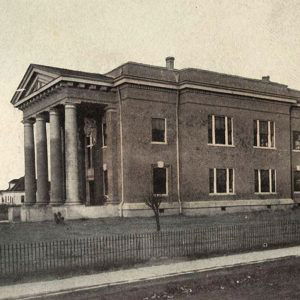calsfoundation@cals.org
Chicot County Courthouse
The Chicot County Courthouse is a 1950s–era Art Deco building incorporating many Corporate or Government Moderne features. It sits at 108 Main Street in Lake Village (Chicot County).
Lake Village was chosen as the seat of local government in 1857, the third city to formally hold the title of county seat since the county was formed from a part Arkansas County in 1823. Both Villemont and Columbia, the former seats, were overtaken by the Mississippi River, and a third location, Masona, was temporary, with no buildings or permanent fixtures ever put in place during its two-year stint as county seat. Lake Village was the fourth and final move for local officials.
The land on which the courthouse and county jail stand was donated by plantation owner John Sumner. It sits across the street from Lake Chicot, the largest oxbow lake in North America and the largest natural lake in Arkansas. The first courthouse, built in 1857, was demolished in 1907 to build a new buff-brick structure with a Classic portico and four pillars of pieced stone. The 1907 courthouse was built by Albert G. Simms, a Lake Village contractor with several other buildings in the area also on the National Register of Historic Places. The second courthouse was razed and replaced with the current courthouse in 1956.
The current three-story courthouse was designed by Herbert Voelker. Voelker had been designing homes, commercial buildings, and public structures in Wichita Falls, Texas, since 1916, and by 1955, he had drafted eleven courthouse plans across Texas. The Chicot County Courthouse was the only building he designed in Arkansas.
Along with his business partner, J. L. Dixon, Voelker was known for his Art Deco and Moderne designs. This can be seen in a fasces, the Roman symbol for authority, which is cast in concrete above the courthouse door. The vertical emphasis that is characteristic of the style is reflected by the continuous concrete casing that spans the second- and third-story windows. Also indicative of the style, scroll relief detailing can be found above the front door, on the side entryways, and under two side windows. As is the case with most Art Deco buildings, the roof has no cornice.
The courthouse has seen few modifications since its construction, maintaining much of its historic integrity. Handrails on the stairs, a radio tower, security cameras, and electrical wiring were added without intruding on the architectural style. A detached utility shed holds the central heating and air units. In 2006, the Chicot County Courthouse was placed on the National Register of Historic Places.
For additional information:
“Chicot County Courthouse.” National Register of Historic Places nomination form. On file at Arkansas Historic Preservation Program, Little Rock, Arkansas. Online at http://www.arkansaspreservation.com/National-Register-Listings/PDF/CH0013.nr.pdf (accessed November 8, 2021).
Gill, John Purifoy, and Marjem Jackson Gill. On the Courthouse Square in Arkansas. N.p.: 1980.
Danny Groshong
Little Rock, Arkansas
 Historic Preservation
Historic Preservation World War II through the Faubus Era, 1941 through 1967
World War II through the Faubus Era, 1941 through 1967 1907 Chicot County Courthouse
1907 Chicot County Courthouse  Chicot County Courthouse
Chicot County Courthouse 



Comments
No comments on this entry yet.